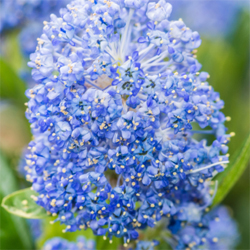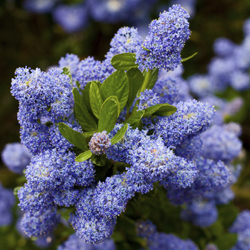An often-underused color in many gardens, blue provides cooling relief from the heat of California summers. And what better plant to use than a member of the native California ceanothus? Perhaps you haven’t heard of the “California lilac,” the common name for a large group of natives. Using one or more of these tough and adaptable plants could be just the touch of color your garden needs. Plus, if these drought conditions continue into future summers, these become the “go-to- plants!
Better yet, there’s a ceanothus for just about every place in the garden. The group includes ground covers, medium height mounding shrubs and tall upright trees easily pruned smaller or to espalier shapes. Most varieties bloom with bright clusters of pale to bright blue although there are a few varieties with white or pinkish tones.
Additionally, they’re easy to grow, just as you assume a native to be. The growing requirements include good drainage and average soil in a sunny to part-shade location. During the summer, after the plant establishes itself, it just requires a couple of deep waterings per month. In fact, some growers’ advice is to “abuse this plant” for successful growing.
Are you worried ceanothus may attract deer or other pests to the garden? Don’t be. While some deer may nibble the ceanothus, consider it “slight pruning.” However, several species of butterflies will thank you for using this native. The Artful Duskywing, California Tortoiseshell, Western Brown Elfin and Doudoroff’s Hairstreak butterflies, among others, visit ceanothus for nectar and to lay eggs. It’s fascinating to watch the eggs hatch to caterpillars (larvae) which then develop into pupae (chrysalis) before the butterfly emerges.
Others also appreciate ceanothus. Seed-eating birds feast on the small shiny seeds. Hummingbirds appreciate the nectar from the scented flowers.
In addition to attracting beautiful natural wildlife, a well-chosen ceanothus, no matter its color, provides its own beauty. The blossom colors stunningly combine with yellows, white and grays in the garden. Planting with red and white flowers creates a “patriotic” garden theme. A moody and trendy color combination may be achieved by pairing ceanothus with soft grays and flowers in shades of Radiant Orchid, the 2014 “color of the year.” Very nice!
No matter why you plant ceanothus, you’ll be happy enjoying its beauty and ease of maintenance, and the knowledge you are providing habitat for birds and butterflies.




